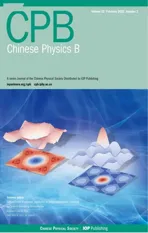Giant low-field cryogenic magnetocaloric effect in polycrystalline LiErF4 compound
2023-03-13ZhaojunMo莫兆军JianjianGong巩建建HuicaiXie谢慧财LeiZhang张磊QiFu付琪XinqiangGao高新强ZhenxingLi李振兴andJunShen沈俊
Zhaojun Mo(莫兆军) Jianjian Gong(巩建建) Huicai Xie(谢慧财) Lei Zhang(张磊)Qi Fu(付琪) Xinqiang Gao(高新强) Zhenxing Li(李振兴) and Jun Shen(沈俊)
1Ganjiang Innovation Academy,Chinese Academy of Sciences,Ganzhou 341119,China
2Key Laboratory of Cryogenics,Technical Institute of Physics and Chemistry,Chinese Academy of Sciences,Beijing 100190,China
3School of Rare Earths,University of Science and Technology of China,Hefei 230026,China
Keywords: LiErF4,magnetocaloric effect,ultra-low temperature
1.Introduction
Ultra-low temperature plays an essential role in a variety of fields, providing crucial support to frontier scientific,such as space exploration, quantum communication, and low temperature physics.[1-5]The currently dominant refrigeration technology for ultra-low temperatures is3He dilution refrigeration.3He is very scarce, expensive, and unstably supplied, which appeals for great interests in alternative refrigeration technology.Magnetic refrigeration technology, based on the magnetocaloric effect(MCE)of magnetic materials,is another viable method to achieve ultra-low temperature.[6-9]Compared with3He dilution refrigeration, its main advantages are the simple construction of device and without the usage of expensive3He.Magnetic entropy change (-ΔSM)is a vital parameter for evaluating the MCE.In the past few decades, a great deal of compounds with large-ΔSMbelow 2 K have been reported, such as Gd3Ga5O12,[10,11]GdF3,[12]GdPO4,[13]Gd(OH)3,[14]Gd(OH)CO3,[15]and Gd(HCOO)3.[16]The recently reported magnetic materials Gd20Ho20Tm20Cu20Ni20,[17]Er20Ho20Gd20Ni20Co20,[18]Gd2MgTiO6,[19]and GdFe2Si2[20]all exhibit excellent magnetocaloric performance.However, for most of them, a large-ΔSMis usually induced by relatively high magnetic field changes(Δµ0H ≥0-2 T),which require expensive superconducting magnets.Low magnetic fields (Δµ0H ≤0-2 T) provided by conventional permanent magnets can remarkably reduce the cost and save the space of magnetic refrigerator.Therefore,there is a growing demand for materials that pursue a large-ΔSMunder a low magnetic field change at ultra-low temperatures.
Lithium rare earth tetrafluorides (LiREF4) with the tetragonal scheelite structure were widely studied because their tightly bound 4f electrons are far enough apart that the dipolar interactions dominate exchange interactions.And excellent MCE of LiGdF4[21]and LiHoF4[22]have been confirmed.The maximum-ΔSMvalues for LiGdF4and LiHoF4are 44.9 J/kg·K and 25.9 J/kg·K under Δµ0H=2 T, respectively.Moreover, dipolar antiferromagnetic material LiErF4receives considerable attention due to its peculiar physical properties.[23-28]In 2012,Kraemeret al.reported that LiErF4is a bilayer antiferromagnet (AFM) with a N´eel temperature(TN)around 0.38 K and any of its nearest neighbor exchange interaction cancels,thus the spin can be easily flipped to ferromagnetic state by applying a low magnetic field.In addition,Kramers doublet ground state isolated by a gap 2.25 meV is also observed from neutron spectroscopy experiment in this compound, which indicates the system can be regarded as a pseudo spin 1/2 system at ultra-low temperature,with the existence of dimensional reduction phenomenon, implying the strong quantum fluctuations in LiErF4.The quantum fluctuations may have significant influence on MCE at ultra-low temperature.What is more, a large number of unreleased magnetic entropy is also observed from the heat capacity measurements.Therefore,LiErF4probably has a large MCE aboveTNinduced by low magnetic fields.
In this work, the crystal structure, cryogenic magnetic properties, and MCE of polycrystalline LiErF4are investigated.It is shown that LiErF4exhibits an AFM phase transition around 0.4 K.A giant MCE induced by a low magnetic field is discovered in LiErF4around 1.3 K,which makes LiErF4an attractive candidate of magnetic refrigerant materials at ultra-low temperature.
2.Experimental details
Polycrystalline LiErF4compound was obtained through solid-state reaction of ErF3and LiF.Firstly, analytically pure ErF3and LiF were thoroughly ground and uniformly mixed according to appropriate proportions,and 40%extra LiF were added to compensate for volatilization during the heating process.Then, the mixture was put in a graphite crucible and this graphite crucible was reversely sealed by another larger graphite one.In order to reduce the oxidation and volatilization,the graphite crucible was put into another corundum crucible, the interspace was full of graphite powder and then sealed with a lid.Finally, the corundum crucible was transferred to a muffle furnace and sintered at 1000°C for 1 hour.The sample was characterized by x-ray powder diffraction (XRD) measurement in Bruker D8A A25 x-ray powder diffractometer by using CuKαradiation.Magnetization measurements were performed on a MPMS with a SQUID(Quantum Design) magnetometer in the temperature ranging from 2 K to 300 K,and the ultra-low temperature magnetic properties were measured on a MPMS-3 with3He insert in the temperature ranging from 0.4 K to 2 K.
3.Results and discussion
Room temperature XRD pattern of LiErF4and the Rietveld refinement curves analyzed by the Rietica software are shown in Fig.1.

Fig.1.Room temperature XRD pattern and Rietveld refinement curve of the LiErF4 compound.The inset presents the crystal structure of LiErF4.
The value ofRp(%) determined from the refinement is 7.01 for LiErF4.Results confirm that the sample is crystallized in the tetragonal scheelite phase (space groupI41/a).The refined lattice parametersa,b, andcwere determined to be 5.162 °A,5.162 °A,and 10.708 °A,respectively.These values are very close to those in previous reports.[29-31]A feeblish extra diffraction peak marked by an asterisk can be observed around 2θ=28°,which was inferred to be the diffraction peak of ErOF produced by the reaction of ErF3with the tiny amount of air remaining inside the crucible.
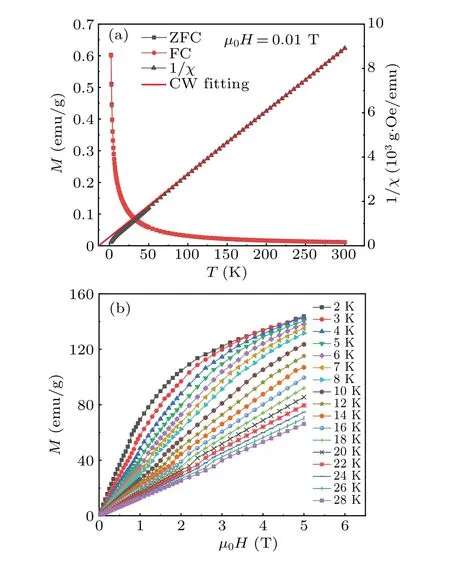
Fig.2.(a)The temperature ranging from 2 K to 300 K,temperature dependence of ZFC and FC magnetization(left scale)and inverse susceptibility 1/χ (right scale) for LiErF4 compound under a magnetic field of 0.01 T.(b) Magnetization isotherms of LiErF4 in the temperature ranging from 2 K to 28 K under magnetic fields up to 5 T.


The magnetic entropy change(ΔSM)can be calculated by the Maxwell equation
The temperature dependence of-ΔSMunder different magnetic fields from 2 K to 28 K is shown in Fig.3.The maximum values of-ΔSMunder the magnetic field change of 1 T,2 T,and 5 T are 7.6 J/kg·K,17.5 J/kg·K,and 26.6 J/kg·K for LiErF4,respectively.
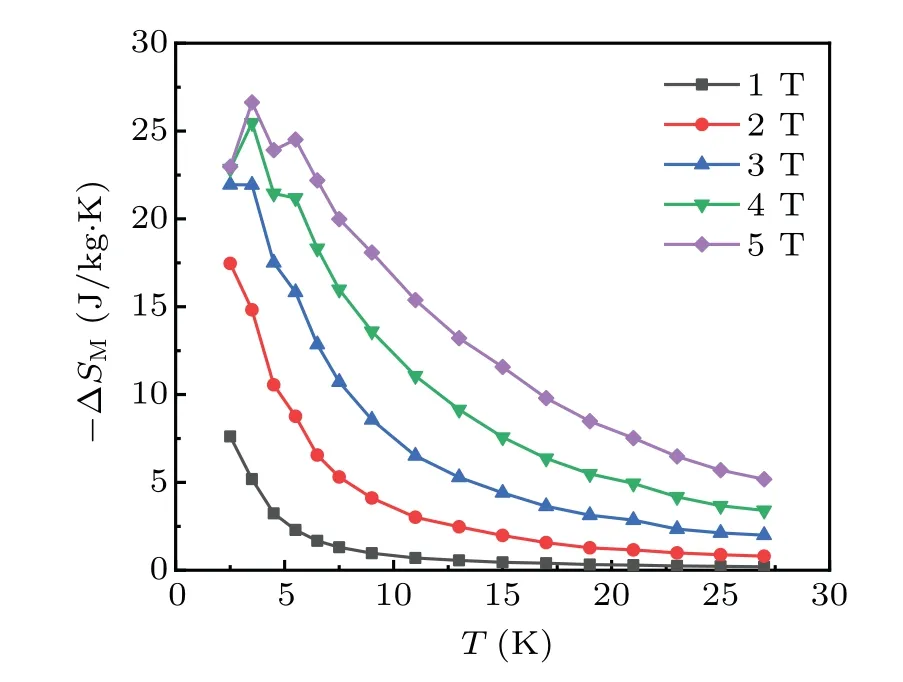
Fig.3.Magnetic entropy change of LiErF4 in the temperature ranging from 2 K to 28 K under Δµ0H from 0-1 T to 0-5 T.
In order to investigate the MCE of LiErF4below 2 K,magnetization measurements were performed in the temperature ranging from 0.4 K to 2 K.The temperature dependences of ZFC and FC magnetizations (M) of LiErF4under 0.01 T are displayed in Fig.4(a).The magnetization values of ZFC in Figs.2(a)and 4(a)have a discrepancy at 2 K,which is probably caused by the different magnetic measurement equipment.Both the ZFC and FC curves increase monotonically as the temperature decreases and the inflection points appear around 0.4 K.A cusp is observed around 0.4 K both in ZFC and FC curves,indicating the occurrence of an antiferromagnetic transition at this temperature,which is consistent withTN=0.38 K reported in previous papers.[23,27,32]
Figure 4(b) shows the isothermal magnetization curve(M-H) measured under magnetic fields of up to 5 T in the temperature ranging from 0.4 K to 1.6 K.The magnetization at ultra-low temperature increases more rapidly with the increase of magnetic field.In addition, all isothermal magnetization curves tend to overlap completely at Δµ0H ≥0-3 T,and does not reach saturation under a magnetic field of 5 T.The magnetization at 5 T is 6.79µB/Er3+,which is significantly smaller than the free Er3+ion saturation momentgJJ=9.0µB.This is attributed to the potential anisotropy of polycrystalline LiErF4,which makes it difficult to saturate the magnetization in the hard axis direction.Kraemeret al.reported thatabplane is the easy magnetization plane andcaxis is the hard magnetization axis for single crystalline LiErF4.[27]Therefore, a larger-ΔSMis expected by applying magnetic field inabplane of single crystalline LiErF4.
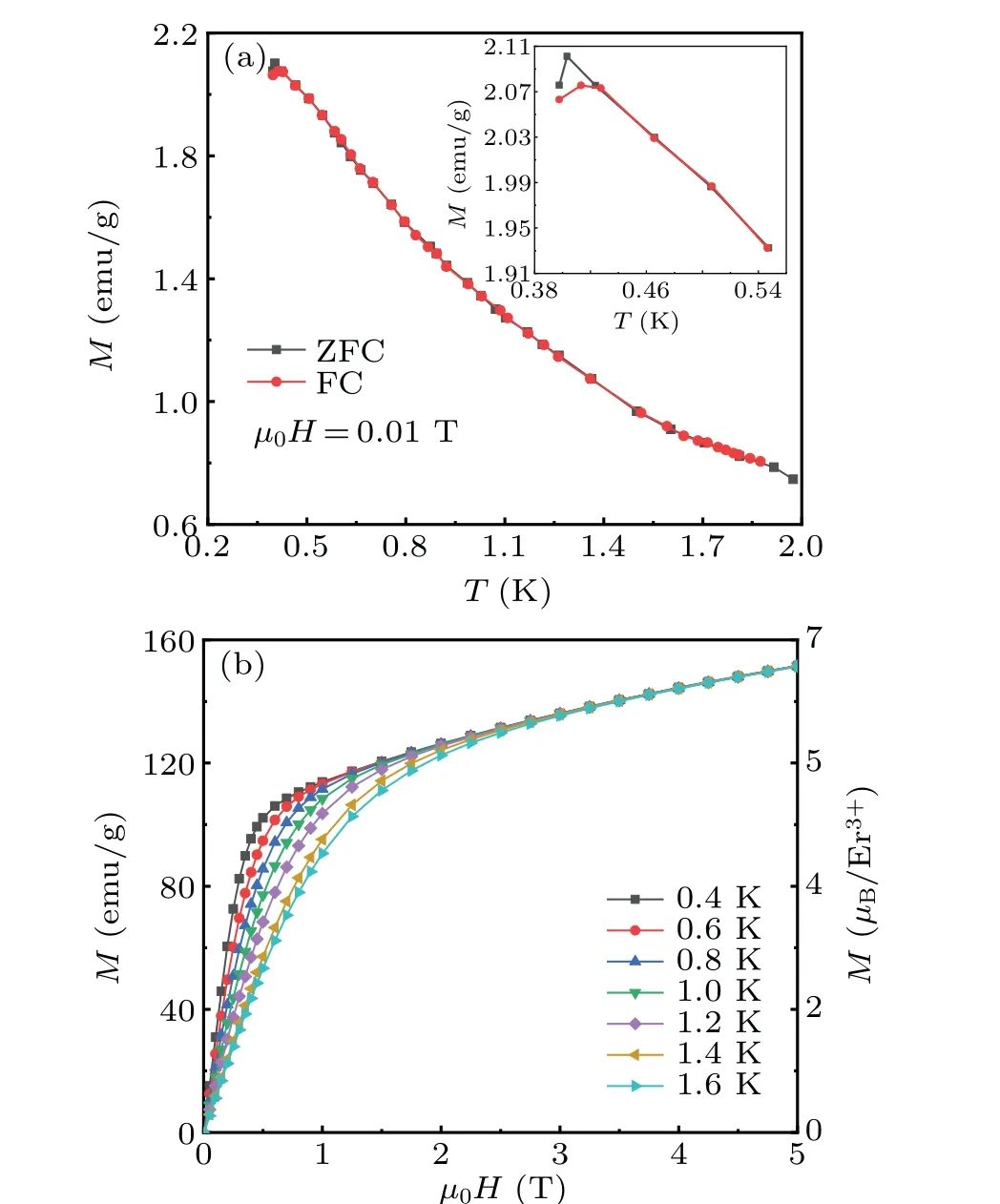
Fig.4.(a)Temperature dependence of ZFC and FC magnetization for LiErF4 in the temperature ranging from 0.4 K to 2 K under a magnetic field of 0.01 T.The inset presents an enlarged view of the temperature from 0.4 K to 0.6 K.(b)Magnetization isotherms of LiErF4 in the temperature ranging from 0.4 K to 1.6 K under magnetic fields up to 5 T.
Figure 5(a) presents that an extremely large-ΔSMin LiErF4is observed aboveTN.The values of-ΔSMare 24.3 J/kg·K, 33.1 J/kg·K, and 49.0 J/kg·K under Δµ0H=0-0.6 T,0-1 T and 0-2 T,respectively.For Δµ0H ≤0-0.6 T,the value of-ΔSMdecreases with increasing temperature.The-ΔSMcurve shows a platform-like shape between 0.4 K and 1.3 K, which is favorable to achieve high cooling efficiency,at which Δµ0His between 0-0.8 T and 0-1 T.However, at Δµ0H ≥0-1.5 T,the value of-ΔSMincreases with increasing temperature and reaches a maximum around 1.3 K.
The giant MCE observed aboveTNmay be due to strong quantum fluctuations which cause a large ratio of the unreleased magnetic entropy existing above the phase transition temperature.[26,27,29,33]Figure 5(b) shows the magnetic field change (Δµ0H) dependences of-ΔSMat selected temperatures.The-ΔSMcurves climb up rapidly under low magnetic field changes (Δµ0H<0-2 T).Especially, at 0.5 K, a giant MCE can be obtained by induced magnetic field below 1 T.While for Δµ0H>2 T,the-ΔSMvalues increase quite slowly,reaching the maximum values of 51.2 J/kg·K,51.7 J/kg·K,and 52.0 J/kg·K for Δµ0H=0-3 T,0-4 T and 0-5 T,respectively.Results show that LiErF4possess a giant MCE induced by a low magnetic field(Δµ0H ≤0-2 T).It is indicated that applied field of 2 T is large enough to motivate the potential MCE of LiErF4compound, which makes it a suitable magnetocaloric material serving in permanent magnets.
For comparison, the magnetocaloric parameters of LiErF4and certain excellent cryogenic magnetic coolants are listed in Table 1.The-ΔSMof LiErF4compound under Δµ0H ≤0-2 T is much larger than those of other refrigerant materials,and theTmax(temperature of the corresponding-ΔSmMax) is extremely low.Notably, the-ΔSMof LiErF4at Δµ0H=0-1 T is much larger than its value at Δµ0H=0-2 T compared to Gd3Ga5O12(GGG), a typical cryogenic magnetocaloric material in the low-temperature region.Therefore,the excellent low-feild MCE makes LiErF4an attractive candidate for magnetic refrigerant materials at ultra-low temperature.
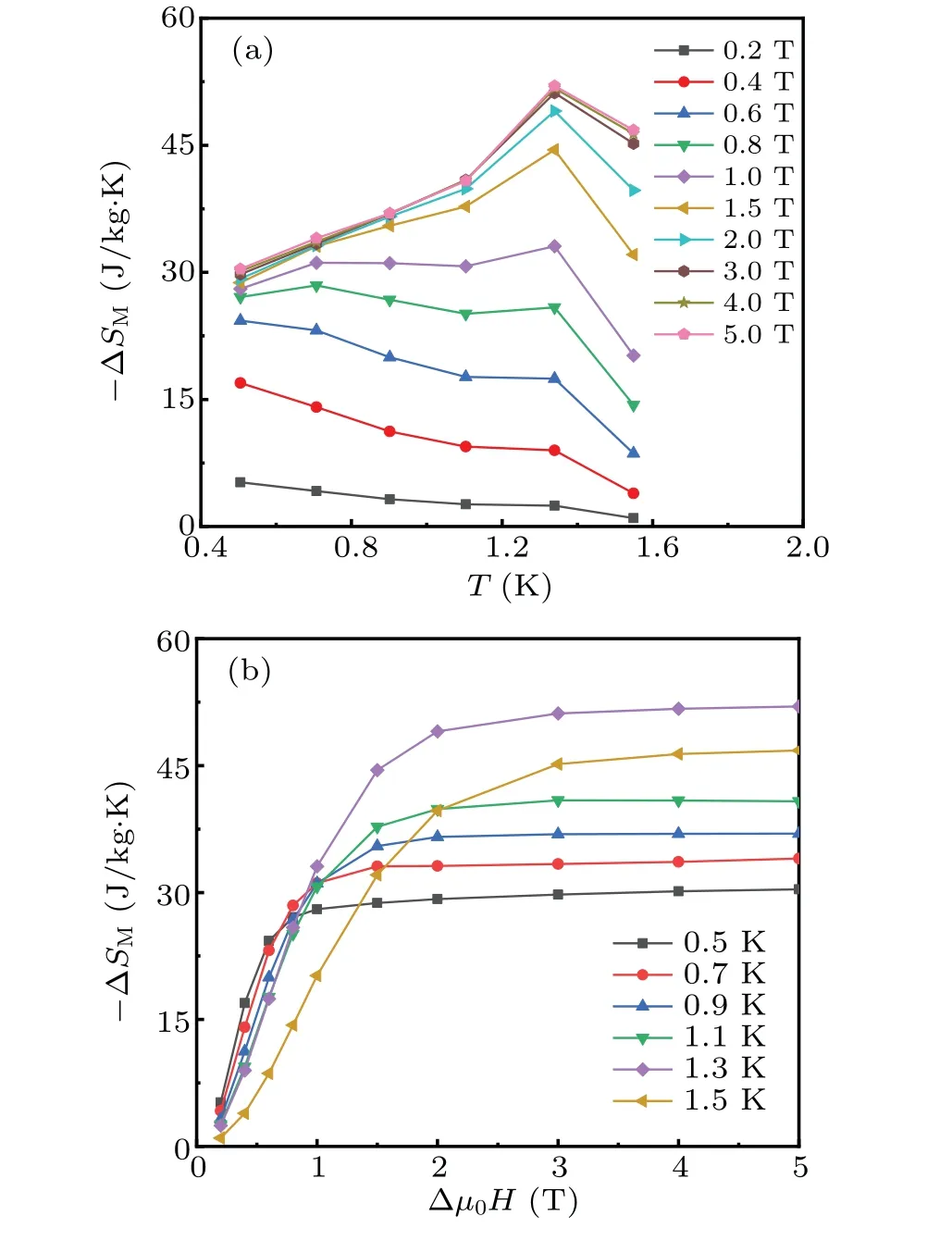
Fig.5.Magnetic entropy changes of LiErF4 in the temperature ranging from 0.4 K to 1.6 K under Δµ0H from 0-0.2 T to 0-5 T(a)as a function of temperature and(b)as a function of the magnetic field change.

Table 1.Experimental values of TN or TC, Tmax and magnetocaloric parameters of LiErF4 compared with certain cryogenic magnetocaloric materials under Δµ0H ≤0-2T.
4.Conclusions
In brief, polycrystalline LiErF4compound with the tetragonal scheelite structure was synthesized, and the cryogenic magnetic properties and MCE were investigated.The compound is identified as an antiferromagnet withTNaround 0.4 K,and a giant MCE is observed aboveTNunder low magnetic fields providable by relatively cheap permanent magnets.The maximum values of-ΔSMare 33.1 J/kg·K and 49.0 J/kg·K around 1.3 K under the magnetic field change of 0-1 T and 0-2 T, respectively.More remarkably, it exhibits a significant magnetic entropy change (24.3 J/kg·K)at magnetic field changes down to 0-0.6 T.The significant low-temperature magnetocaloric performance at low magnetic field proves that the LiErF4compound is a competitive magnetic refrigerant candidate for ultra-low temperature refrigeration.
Acknowledgements
Project supported by the National Science Fund for Distinguished Young Scholars of China (Grant No.51925605),the National Natural Science Foundation of China (Grant No.52171195), the Key Research Program of the Chinese Academy of Sciences(Grant No.ZDRW-CN-2021-3),the Basic Frontier Scientific Research Program of Chinese Academy of Sciences From 0 to 1 Original Innovation Project (Grant No.ZDBS-LY-JSC017), and the Scientific Instrument Developing Project of Chinese Academy of Sciences (Grant No.YJKYYQ20200042).
猜你喜欢
杂志排行
Chinese Physics B的其它文章
- Matrix integrable fifth-order mKdV equations and their soliton solutions
- Comparison of differential evolution,particle swarm optimization,quantum-behaved particle swarm optimization,and quantum evolutionary algorithm for preparation of quantum states
- Explicit K-symplectic methods for nonseparable non-canonical Hamiltonian systems
- Molecular dynamics study of interactions between edge dislocation and irradiation-induced defects in Fe-10Ni-20Cr alloy
- Engineering topological state transfer in four-period Su-Schrieffer-Heeger chain
- Spontaneous emission of a moving atom in a waveguide of rectangular cross section
